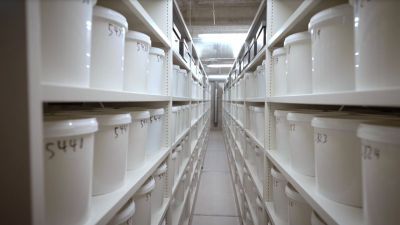Why scientists believe this collection of human brains could hold key to new treatments

At one of Denmark's biggest universities, tucked away in a corner on campus, is a room that contains almost 10,000 buckets of brains.
That was perhaps not where you assumed that sentence was going and, although it's hard to believe, it's thought this is the biggest collection of brains in the world.
It was all the work of two psychiatric doctors who wanted to understand the mysteries of what causes mental illness.
So between 1945 and the early 1980's, when their patients died, the doctors would remove the brains before they were buried, examine them and make detailed handwritten notes.
What makes this collection so unique isn't just the quantity of brains, but the variety too.
They're from patients of all ages, who lived with a range of diseases and conditions, from Alzheimers to Schizophrenia and, crucially, the brains taken in the first decade have been untouched by modern medicine.
Scientists today believe these so called 'virgin brains' could be the key to unlock the collection's full potential but they haven't been studied for decades.
Currently the brains are kept safe, in buckets filled with formaldehyde in the basement of the anatomy department of the university.
In Odense, I met the man in charge of looking after them, Martin Wirenfeldt. He says he wants to honour what the original doctors were trying to achieve, but he needs funding to research the brains and a huge dedicated team.
"I think it's very important to make sure that we honour them the best way we can. The more they're used, the better, really, the more they can contribute to new treatments," he said.
This collection, though, has had a controversial journey because patients didn't know they were giving their brains away for science.
Most would never have known their brains would be removed when they died and, by today's standards of ethics, it's hard to grasp how this could happen.
But while it would be true to say the patients never gave their consent for their brains to be used for science, it would also be true to say consent as we know it today simply didn't exist then.
Some relatives in the 1990's did challenge the use of the brains, suggesting instead that they should be buried. But by 2006 Denmark’s ethics committee agreed they could be studied.
Want a quick and expert briefing on the biggest news stories? Listen to our latest podcasts to find out What You Need To Know
Bienta Eriksen was a psychiatric nurse who looked after patients for 34 years. Now, though, her hospital has become a museum that she runs. It’s dedicated to this part of the country's history.
She says that back then patients who came to hospital with mental illness that needed to be treated, never left. She told me that many patients came to hospital as teenagers, lived there for decades and died as elderly people.
Hundreds are buried on the grounds at her old hospital and Bienta says she never walks over the part where she knows they've been laid to rest.
Before patients were buried, a small ceremony was often held at chapels on the grounds.
Jesper Kragh is a historian and he showed me the autopsy room tucked behind the chapel where patient’s brains were removed. He says once removed, the brains were placed in a wooden box and sent via mail to be examined.
Back in Copenhagen, I met Susanna Aznar who works at the Centre for Neuroscience. She researches modern brains that patients have donated to be studied.
"The brain is where our soul is. That's where our thoughts are. That's where our consciousness is… that's the way we conceive the world. That's the way where defines who we are," she said.
It’s one of the reasons why so few are donated upon death, and one of the reasons why the old brain collection is so valuable, Susanna believes.
As we were filming she gave me the unique opportunity to hold a human brain. It was such an extraordinary experience and very much a privilege.
You can watch On Assignment at 10.55pm on Tuesday 28th March on ITV1.